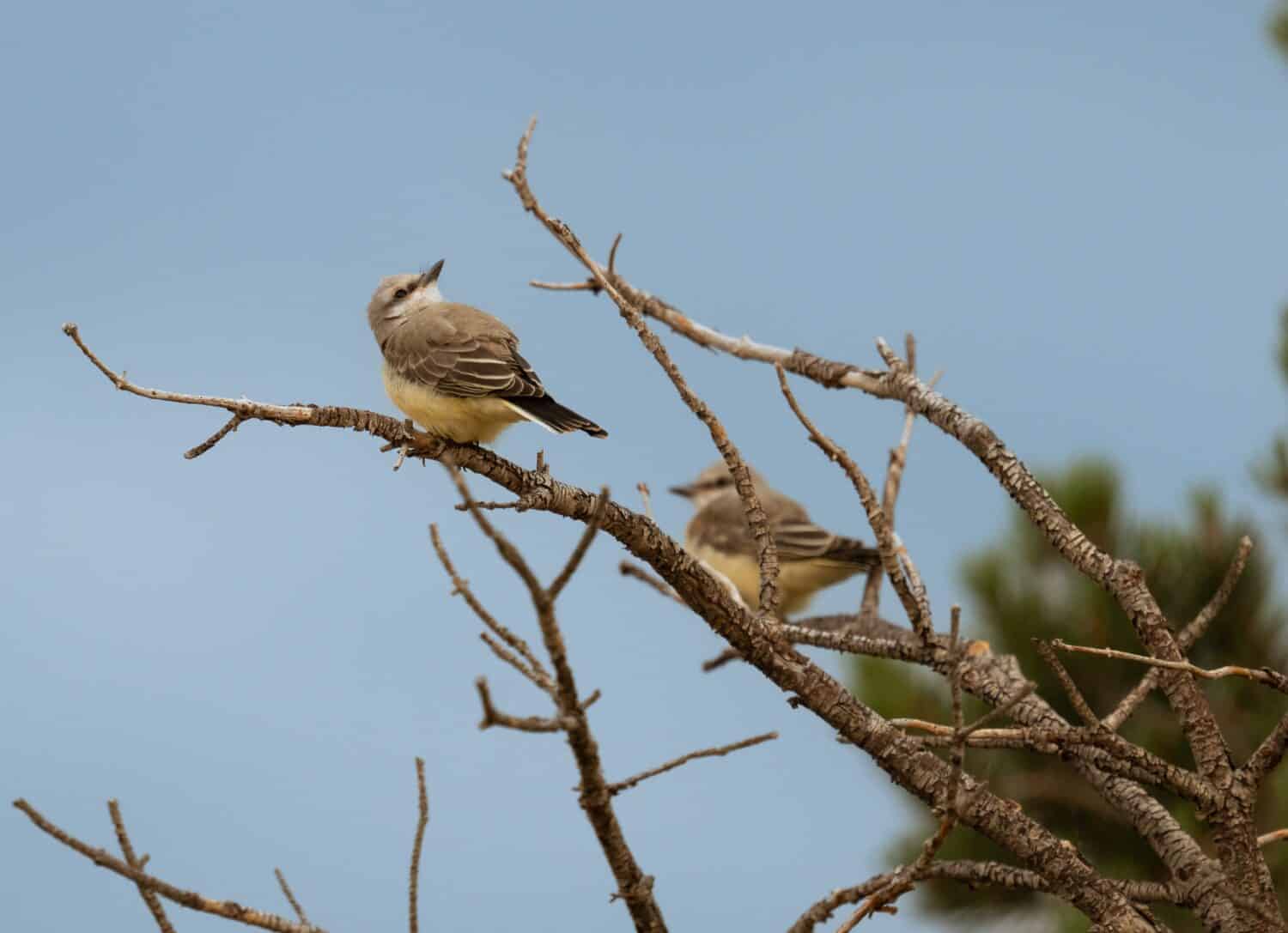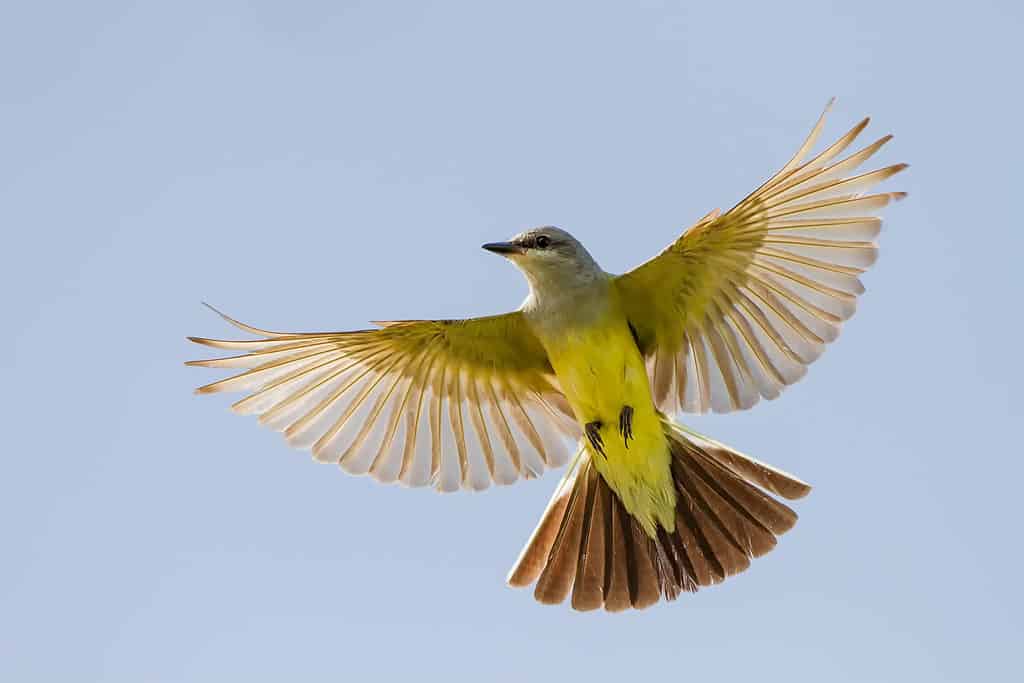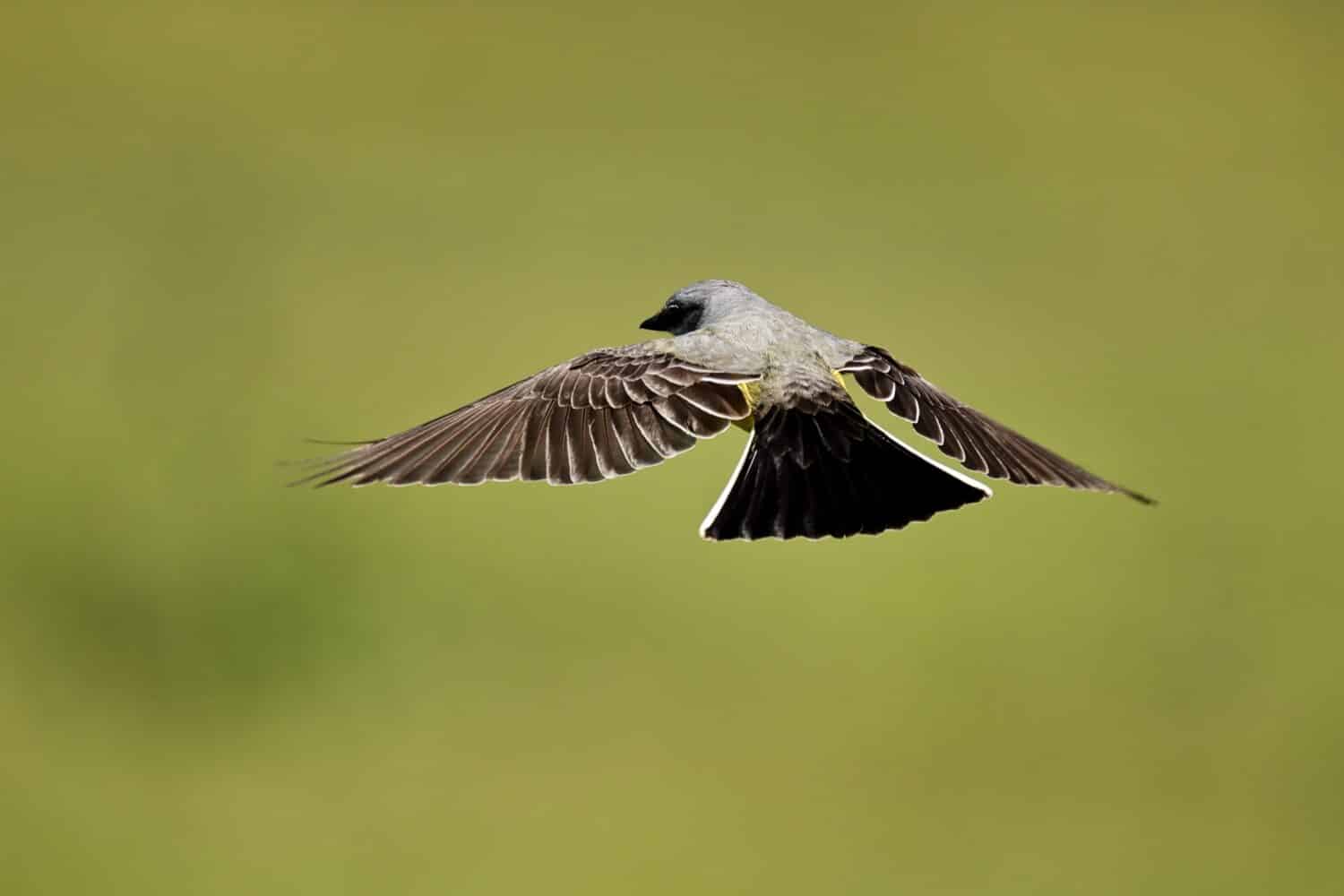Western Kingbird
Tyrannus verticalis
Western kingbirds have hidden red crown feathers that they can raise when threatened!
Advertisement
Western Kingbird Scientific Classification
- Kingdom
- Animalia
- Phylum
- Chordata
- Class
- Aves
- Order
- Passeriformes
- Family
- Tyrannidae
- Genus
- Tyrannus
- Scientific Name
- Tyrannus verticalis
Read our Complete Guide to Classification of Animals.
Western Kingbird Conservation Status
Western Kingbird Facts
- Prey
- Insects, arachnids
- Main Prey
- Insects
- Group Behavior
- Solitary except during mating season
- Fun Fact
- Western kingbirds have hidden red crown feathers that they can raise when threatened!
- Estimated Population Size
- 30 million
- Most Distinctive Feature
- Yellow belly
- Wingspan
- Between 15.0 and 16.1 inches
- Incubation Period
- 12 to 19 days
- Age Of Fledgling
- 12 to 19 days
- Habitat
- Open grasslands, forest edges
- Diet
- Omnivore
- Nesting Location
- In trees, shrubs, or man-made structures
- Migratory
- 1
View all of the Western Kingbird images!
Western Kingbird Summary
“Western kingbirds have hidden red crown feathers that they can raise when threatened!”
The western kingbird is a large species of tyrant flycatcher native to North America. They are aggressive when necessary and are known to chase away other birds that tread too close. This includes larger birds of prey, like red-tailed hawks. They are common in rural backyards, and though they typically eat a diet of invertebrates, they may occasionally eat berries as well.
Western Kingbird Amazing Facts
- Unlike many species harmed by human influence, humans have helped increase the range of this bird.
- As far as researchers understand, western kingbirds didn’t begin wintering in Florida until 1915.
- Although small compared to birds of prey, western kingbirds are aggressive and will chase off predators or intruders.
- This species was originally named the Arkansas kingbird.
Where to Find Western Kingbirds
The western kingbird is native only to North America. They reside in the western region of the continent, although they winter as far east as Costa Rica and Florida. During the breeding season, you can find them in the northernmost extent of their range, from northern Mexico up to southern Canada. They winter in Florida and along the southernmost coasts of Mexico and Central America, with their migratory locations spanning the gap between winter and breeding grounds.
This species is often found in open grassland or on woodland edges near these habitats. However, they also have a tendency to reside in human structures, building their nests on utility poles, fence posts, and similar areas.

Western kingbirds often perch on trees or human structures.
©BrianSl/Shutterstock.com
Western Kingbird Nests
As of now, it is unclear whether the male or the female in the breeding pair will choose the nesting location. However, what is known is that both individuals will visit potential nesting locations. Typical areas for the western kingbird to build its nest include different trees, such as cottonwood or pecan trees, as well as man-made structures.
While it isn’t known which of the pair chooses the nesting location, the female is responsible for constructing the nest. She weaves together a variety of different plant materials, including bark, rootlets, and stems, to create an open cup. Once the skeleton of the nest is made, the female will line the inside of the nest with soft material. This includes wool, feathers, and cloth.
The final nest measures around 6 inches wide and 4 inches deep, although the usable inner cup of the nest is half that size.
Western Kingbird Scientific Name
The scientific name of the western kingbird is Tyrannus verticalis. It is in the class Aves, which contains all species of birds, and in the order Passeriformes. It is in the family Tyrannidae, which is the family of tyrant flycatchers.
Western Kingbird Size, Appearance, and Behavior
The western kingbird is a large flycatcher lacking sexual dimorphism. This means that males and females of the species look the same. They sport grey heads, with pale throats and a yellow belly. The tail is black, with the outer feathers being white. Both sexes of this species sport a reddish-orange crown. These colorful feathers are located around the top of the head and are often concealed by the outer grey feathers.
The adult western kingbird will grow to be 7.9 to 9.4 inches in length. On average, they weigh 1.3 to 1.6 ounces. What is most impressive is their wingspan, which is often between 15.0 and 16.1 inches.
These birds are most often seen perching. Whether on natural structures, such as trees or shrubs, or man-made structures, such as fences, they often sit and watch for nearby prey and predators. They capture their prey while flying, whether that includes capturing a nearby, airborne insect or plucking one from the ground or plants while hovering.
They are aggressive only in that they are territorial. They will defend their territory using a variety of calls and gestures. When necessary, they may also attack intruders in their territory, as is often the case when encountering crows.

The western kingbird’s underbelly is a bright yellow.
©Wildvet/Shutterstock.com
Western Kingbird Migration Pattern and Timing
The western kingbird is a medium- to long-distance migrant with no significant year-round populations. They begin their southward migration at the end of the summer period. This species winters most often in Mexico and Central America, along with the southernmost tip of the Florida panhandle. Prior to arriving in their winter grounds, they will stop along the route, appearing in states such as New Mexico and Arizona.
Come spring, these birds will migrate north again for the breeding season, often appearing in the same migratory states as they did when traveling southward.
Western Kingbird Diet
Like other species of tyrant flycatchers, the western kingbird is primarily an insectivore. They hunt in the air during the day, often catching more than one insect to return to their perch with. Not only do they catch insects in flight, but they may also occasionally pluck terrestrial prey from the ground as well as from plants while hovering.
Although insects make up the majority of their diet, they may also eat certain plant materials, namely berries. Other invertebrates, such as arachnids, are often consumed.

These birds will often capture their prey mid-flight or while hovering.
©Ocimadfoto/Shutterstock.com
What Do Western Kingbirds Eat?
Some of the plant and animal matter western kings will consume include:
- Bees
- Wasps
- Grasshoppers
- Crickets
- Beetles
- Moths
- Butterflies
- Caterpillars
- Flies
- Spiders
- Elderberry
- Hawthorn fruit
- Texas mulberry
- Woodbine fruit
Western Kingbird Predators and Threats
Although western kingbirds gain benefits from human influence, such as additional perching and nesting locations, there are also several threats they face as a result of humans. One of the main threats is agricultural pollution. As insectivores, these flycatchers consume a large number of invertebrates, and their fondness for open spaces often leaves them hunting near crop fields. This can result in these kingbirds consuming animals affected by pesticides.
There are also natural threats. This includes those such as storms and predators.
What Eats Western Kingbirds?
Western kingbirds may fall prey to a variety of different animals. This includes the following animals.
- Crows
- Bluejays
- Snakes
- Squirrels
- Hawks
Western Kingbird Reproduction, Babies, and Lifespan
Western kingbird pairs are monogamous. Males will arrive at the breeding grounds first and, once mated, will defend the territory with the female. Together, the pair will protect and raise their young, remaining nearby to help the fledglings up to three weeks after they leave the nest. For the rest of the year, western kingbirds are solitary.
These birds can lay anywhere from 2 to 7 eggs. These eggs are small, averaging 0.9 inches in length and 0.7 inches in width. The outer shell of the egg is white or pinkish, with large blotches in colors such as brown, black, or even lavender.
The incubation period for the western kingbird is 12 to 19 days. The hatchlings will emerge with their eyes closed and only a sparse covering of down, rendering them helpless without their parents. The nesting period lasts 12 to 19 days, after which the young fledge and leave the nest. However, as mentioned above, the parents will continue to help the young kingbirds for up to three weeks after this point.
During their southward migration to their wintering habitats, adults will undergo a complete molt. This species has an average lifespan of around 6 years.

Western kingbirds will tend to their fledglings for several weeks.
©J Hopwood/Shutterstock.com
Western Kingbird Population
The western kingbird is a species of least concern. Between 1966 and 2019, they maintained an overall stable population with no significant, long-term inclines or declines. It is estimated that the global breeding population totals around 30 million.
The largest changes in this species’ population are often seen on a local level rather than global. Temporary changes, such as an increase in predation or natural disasters, can impact birds in that area without harming the total population. Western kingbirds have also proven an ability to rebound quickly after declines, allowing them to maintain their population.
View all 108 animals that start with WWestern Kingbird FAQs (Frequently Asked Questions)
Do western kingbirds migrate?
Yes, for breeding season and for wintering.
How many eggs do western kingbirds lay?
They lay between 2 and 7 eggs per brood, of which they can have up to two in a year.
What is the western kingbird's wingspan?
Their wingspans measure between between 15.0 and 16.1 inches.
When do western kingbird's leave the nest?
The nestling period lasts between 12 and 19 days.
Thank you for reading! Have some feedback for us? Contact the AZ Animals editorial team.
Sources
- , Available here: https://www.pwrc.usgs.gov/bbs/about/
- (1970)

















